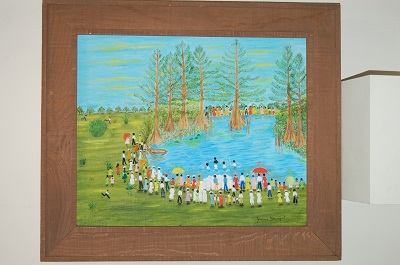Jennie Lee Gorton & D. Gorton: The Art of Recording History in the South
- Ninfa O. Barnard
- Aug 6
- 3 min read
Jennie Lee Gorton and D. Gorton, mother and son artists, who used their crafts to record the history of the South. Jennie Lee Gorton was a nationally acclaimed ethnographic painter who documented the lives of African Americans in the Mississippi Delta region. While her son D. Gorton is a photojournalist who traveled across the American South, documenting the lives of white Southerners as the end of legal segregation changed their way of life.
Left: Baptizing (Mississippi Delta Plantation Scene)
Image Credit: https://aquila.usm.edu
Right: The Shotgun House
Image Credit: https://americanhistory.si.edu
Painter: Jennie Lee Gorton
Left: Fashion Show, Greenville, Mississippi
Middle: Plantation ladies near Greenville, Mississippi, 1969
Right: Mother and daughter with cab driver in background, New Orleans, Louisiana, 1970
Image Credit: https://oxfordamerican.org
Photographer: D. Gorton
Jennie Lee Wharton was born February 15, 1905, in Pine Bluff, Arkansas. On June 21, 1926, Wharton married Doy DeWitt Gorton, a traveling salesman who traveled throughout the Mississippi and Arkansas Delta providing plantation commissaries, country stores, and rural grocery stores with goods. Gorton and her husband went on to have three children: Aubrey June Gorton Hammond (1927), Ellen Douglas "Chick" Gorton Daniels (1929), and Doy (D.) Gorton (1942).
Although raised with privilege in what he termed “legalized white supremacy,” D. Gorton participated in the Civil Rights movement, joined the Student Nonviolent Coordinating Committee (SNCC), and started an underground newspaper at Ole Miss. (University of Mississippi).
From 1969 to 1970, D. Gorton embarked on a photography project to explore the lives of white Southerners, examining issues of caste, class, and race, as well as social and economic change, during the final days of legal white supremacy. He documented blue-collar workers with compassion and showcased some of the few places on the edge of Southern society, such as Pentecostal revivals or mental asylums that were truly integrated. On July 25, 2025, Doy Gorton’s White South 1969-1970 with Jane Adams, was published by Fall Line Press of Atlanta, chronicling this period.
Today, D. Gorton is a well-respected photojournalist. He was Chief Photographer at the Philadelphia Inquirer. He captured photos of the Carter and Reagan administrations as a New York Times photographer. He was a special photographer for films such as Glory, A River Runs Through It, Eight Men Out, and Fried Green Tomatoes. He also worked with Sony, Warner Bros, and other music companies on album art for Fleetwood Mac, Canned Heat, Janis Joplin,and other artists. He was the editor on “Day in the Life of the Soviet Union” as well as “A Day in the Life of America,” which documented entire nations in one 24-hour day with over 200 photographers from across the globe. D. Gorton now lives in Carbondale, Illinois, with his wife Jane Adams.
After her husband died in 1966, Jennie Lee Gorton became a nationally acclaimed ethnographic painter, documenting the lives of African Americans in the Mississippi Delta region. Her work has been featured by the University of Southern Mississippi Oral History Program and Art Museum, the Smithsonian Institute’s National Museum of American History, and the White House. Her work is also featured in the University of Mississippi Museum’s Southern Folk Art collection, showcasing Southern culture from the late 19th and 20th centuries. In an interview with the Mississippi Moment with Bill Ellison, Gorton details how two of her paintings ended up at the Smithsonian Institute.
Gorton died on December 26, 1998. She is survived by her son, D. Gorton, and numerous grandchildren and great-grandchildren.
Sources:
D. Gorton
Jennie Lee Gorton
Written by: Ninfa O. Barnard

















Comments